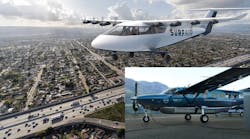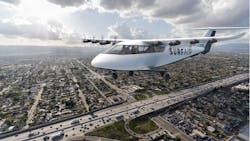What you’ll learn:
- Hybrid-electric aircraft combine the best of electrical and conventional propulsion systems, enabling today's battery technologies to do most of the "heavy lifting" in smaller commercial aircraft.
- Based on successful tests of prototypes, hybrid-electric aircraft promise to dramatically reduce the fuel consumption and operating costs of air taxi, air charter, and regional air carrier services.
- Several manufacturers are expected to bring hybrid-electric passenger aircraft to market by 2025.
Though all-electric airliners may be a decade or more away, several hybrid-electric aircraft are nearing commercial production. And they may have a shot at changing the economics of regional, short-haul, and air taxi services.
These aircraft, whose electric propulsion units are powered primarily by batteries, also carry an onboard generator to provide supplemental power for takeoff and serve as inflight range extenders. The reduced battery weight makes operation feasible using today's storage technologies while reducing fuel consumption anywhere between 50% and 80%.
Two of the leaders in the commercialization of hybrid aircraft are Surf Air Mobility Inc. and Electra.aero Inc. (“Electra”). They have joined forces to use Electra’s hybrid-electric short takeoff and landing (eSTOL) to make affordable, sustainable, and easily accessible regional air travel to many of the United States' nearly 5,000 public use airports (Fig. 1).
The 9-passenger, 200-mph production aircraft, based on a successfully tested prototype, will enable Surf Air to provide economical on-demand air mobility services. The 90-unit pre-order from Surf Air adds to 2,000+ aircraft pre-orders and options already placed by over 35 key operators.
Electra's eSTOL is designed to fill a gap in transportation between 50 to 500 miles, bringing air service to thousands of communities where air travel today isn’t a practical or affordable option. It does this using a combination of hybrid-electric propulsion and a "blown lift" short take-off and landing (STOL) system. The blown-lift system consists of series of electrically driven propellers distributed across an aircraft's wing with specialized flaps that enable it to capture the propwash and translate it into lift (Fig. 2).
Because it uses a relatively conventional (simple) motor and wing structure to generate its lift, the system can deliver many of the advantages of vertical take-off (VTOL) systems at much higher efficiencies and a fraction of their cost and complexity.
An 80% scale, a technology demonstrator equipped with Electra's blown-lift STOL system has proven the basic feasibility of its technologies. As shown in the video above, the technology demonstrator took to the skies for the first time for an all-electric test flight on November 11, 2023, and a hybrid-electric flight launched on November 19. Based on initial tests of its prototype, Electra estimates its production craft will be able to safely operate from airfields as short as 300 feet.
Development of a prototype of the production aircraft is underway. The production prototype's batteries will be supplemented by a 600 kW electric turbogenerator propulsion system, manufactured by Safran Helicopter Engines, which will provide enhanced power for takeoff and serve as a range extender.
Surf Air Mobility has been operating a large fleet of conventional turboprop planes to deliver commuter aviation and air charter services for over 10 years and is now looking to electrify the majority of their fleet. In addition to Electra's aircraft, Surf's new fleet will include up to 150 units of an electrified version of Cessna's rugged Grand Caravan cargo plane, developed in partnership with Textron Aviation (Fig. 3).
Stay tuned to Electronic Design's Power technology channel for an upcoming feature that takes deep dive into the technologies behind hybrid-electric aircraft and a gives you close-up look at some of the aircraft expected to enter the market in the next two to three years.
Reference
Christopher B. Courtin, R. John Hansman, Mark Drela, “Flight Test Results of A Subscale Super-STOL Aircraft,” MIT International Center for Air Transportation (ICAT) January, 2020, Report No. ICAT-2020-01.



